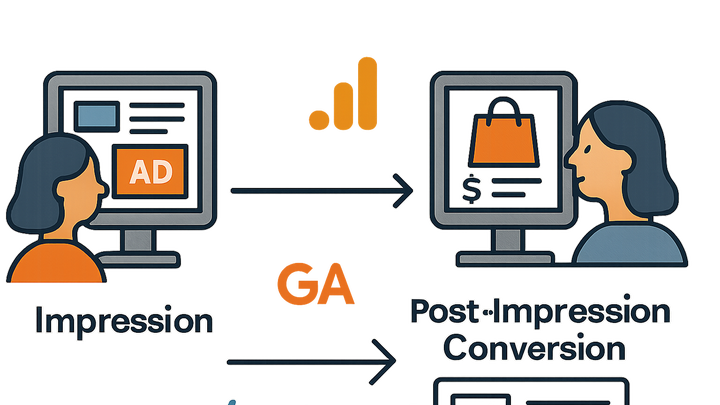Published on 2025-06-26T05:19:54Z
What is Post-Impression Conversion? Examples and Tracking with PlainSignal and GA4
In digital marketing analytics, a Post-Impression Conversion occurs when a user converts (e.g., makes a purchase or completes a goal) after viewing an advertisement but without directly clicking on it. This metric captures the value generated from the ad exposure itself, often called a view-through conversion. Post-Impression Conversions are essential for measuring brand campaigns and display ads where users are influenced by visuals rather than clicks. Tracking tools like Google Analytics 4 (GA4) and PlainSignal (a cookie-free, privacy-focused analytics platform) can capture these conversions by attributing conversion events to prior ad impressions within a defined attribution window. Analysts use this data to assess the full impact of ad impressions on user behavior and optimize ad spend accordingly. By understanding Post-Impression Conversions, marketers can quantify indirect ad effects and improve holistic campaign performance.
Post-impression conversion
Tracks conversions by users who saw (but didn't click) an ad, enabling view-through attribution and ad spend optimization.
Definition and Context
Post-Impression Conversions measure when users convert after viewing an ad, without clicking. This metric captures the influence of ad impressions on subsequent conversions and is also called view-through attribution. It complements click-through conversion metrics by showing the broader impact of ad exposure.
-
What is a post-impression conversion?
A Post-Impression Conversion occurs when a user completes a desired action (like making a purchase or signing up) after seeing an ad but not clicking on it.
-
Post-impression vs. post-click attribution
Unlike post-click conversions—which attribute conversions to direct ad clicks—post-impression conversions attribute based on prior ad views within the attribution window.
-
Post-click conversion
Records conversions when users click an ad and convert.
-
View-through (post-impression) conversion
Records conversions when users see an ad and later convert without clicking.
-
Why Post-Impression Conversions Matter
Understanding post-impression conversions helps marketers capture the full value of their ad spend and optimize campaigns beyond clicks.
-
Capturing brand exposure
Even without clicks, ad impressions drive brand awareness and can lead to user actions later.
-
Optimizing ad spend
By measuring view-through conversions, advertisers can allocate budgets to campaigns that influence users indirectly.
Tracking Post-Impression Conversions
Different analytics platforms offer various methods to track post-impression conversions, including GA4 and PlainSignal.
-
Google analytics 4 setup
In GA4, configure view-through conversions by linking Google Ads and customizing attribution settings.
-
Link GA4 to google ads
Go to Admin > Property > Product Links > Google Ads links to import view-through conversions.
-
Customize conversion events
Create or modify conversion events in GA4 and adjust attribution settings under Admin > Attribution Settings.
-
-
PlainSignal implementation
PlainSignal uses a cookie-free script to track impressions and conversions directly on your site.
-
Snippet installation
Add this code before the closing </head> tag:
<link rel="preconnect" href="//eu.plainsignal.com/" crossorigin /> <script defer data-do="yourwebsitedomain.com" data-id="0GQV1xmtzQQ" data-api="//eu.plainsignal.com" src="//cdn.plainsignal.com/plainsignal-min.js"></script>
-
Example Scenarios
Practical use cases demonstrating post-impression conversion tracking in real campaigns.
-
E-commerce display campaign
A retail website measures purchases from users who viewed display ads on partner sites but did not click. GA4 and PlainSignal dashboards show lift in conversions attributed to impressions.
-
Brand awareness initiative
A new product launch campaign tracks newsletter signups from users who saw social media ads but engaged later. Post-impression data helps quantify branding impact.
Best Practices and Considerations
Key factors to ensure accurate measurement of post-impression conversions.
-
Attribution window selection
Choose an appropriate time window (e.g., 7 or 30 days) that reflects user behavior and campaign goals.
-
Viewability and fraud
Ensure ads are actually viewable; filter out invalid impressions to prevent inflated metrics.
-
Privacy and cookie-free tracking
Adopt privacy-compliant methods like PlainSignal to track impressions without cookies and respect user consent.
